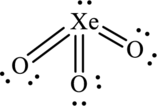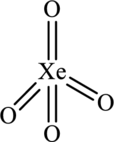
Concept explainers
Interpretation:
Lewis structure, hybridization, and bond angle of
Concept Introduction:
Hybridization is calculated by the hybrid orbitals and to calculate hybrid orbitals we need to know the steric number that is given by,
The table that relates the steric number with hybridization is as follows:
The table that relates steric number with geometry and bond angles is as follows:
Answer to Problem 2F.14E
Hybridization of
Explanation of Solution
The molecule
The symbol for xenon is
The symbol for oxygen is
Thus total valence electrons are sum of the valence electrons for each atom in
The skeleton structure
To complete the octet of xenon it forms a double bond with three oxygen atom.
Hence, 14 electrons are allocated as 2 lone pairs on each oxygen atoms and 1 lone pair on xenon atom to complete their octet. The Lewis structure is as follows:

In the structure of
Substitute 3 for number of atoms bonded with central atom and 1 for lone pair on central atom in equation (1) to calculate steric number.
Since, the steric number of the molecule
The molecule
The symbol for xenon is
The symbol for oxygen is
Thus total valence electrons are sum of the valence electrons for each atom in
The skeleton structure
To complete the octet of xenon it forms a double bond with four oxygen atoms.
Hence, 16 electrons are allocated as 2 lone pairs on each oxygen atoms to complete its octet. The Lewis structure is as follows:

In the structure of
Substitute 4 for atoms bonded with central atom and 0 lone pair on central atom in equation (1) to calculate steric number.
Since, the steric number of the molecule
The molecule
The symbol for xenon is
The symbol for oxygen is
Four negative charges on molecule are added up in the total valence count.
Thus total valence electrons are sum of the valence electrons for each atom in
The skeleton structure
To complete the octet of xenon it forms a double bond with two oxygen atoms.
Hence, 32 electrons are allocated as 2 lone pairs on two doubly bonded oxygen atoms and 3 lone pairs on remaining oxygen atoms to complete their octet. The Lewis structure is as follows:

In the structure of
Substitute 6 for number of atoms bonded with central atom and 0 for lone pair on central atom in equation (1) to calculate steric number.
Since the steric number of the molecule
Bond order is the number of electrons involved between the two atoms in a molecule. Bond order is inversely related to bond length.
In
Want to see more full solutions like this?
Chapter 2 Solutions
Chemical Principles: The Quest for Insight
- Synthesize 2-Ethyl-3-methyloxirane from dimethyl(propyl)sulfonium iodide using the necessary organic or inorganic reagents. Draw the structures of the compounds.arrow_forwardSynthesize 2-Hydroxy-2-phenylacetonitrile from phenylmethanol using the necessary organic or inorganic reagents. Draw the structures of the compounds.arrow_forwardSynthesize N-Methylcyclohexylamine from cyclohexanol using the necessary organic or inorganic reagents. Draw the structures of the compounds.arrow_forward
- Synthesize N-Methylcyclohexylamine from cyclohexanol using the necessary organic or inorganic reagents. Draw the structures of the compounds.arrow_forwardIf possible, please provide the formula of the compound 3,3-dimethylbut-2-enal.arrow_forwardSynthesize 1,4-dibromobenzene from acetanilide (N-phenylacetamide) using the necessary organic or inorganic reagents. Draw the structures of the compounds.arrow_forward
- Indicate the products obtained by mixing (3-oxo-3-phenylpropyl)triphenylphosphonium bromide with sodium hydride.arrow_forwardWe mix N-ethyl-2-hexanamine with excess methyl iodide and followed by heating with aqueous Ag2O. Indicate the major products obtained.arrow_forwardIndicate the products obtained by mixing acetophenone with iodine and NaOH.arrow_forward
- Indicate the products obtained by mixing 2-Propanone and ethyllithium and performing a subsequent acid hydrolysis.arrow_forwardIndicate the products obtained if (E)-2-butenal and 3-oxo-butanenitrile are mixed with sodium ethoxide in ethanol.arrow_forwardQuestion 3 (4 points), Draw a full arrow-pushing mechanism for the following reaction Please draw all structures clearly. Note that this intramolecular cyclization is analogous to the mechanism for halohydrin formation. COH Br + HBr Brarrow_forward
 Chemistry: An Atoms First ApproachChemistryISBN:9781305079243Author:Steven S. Zumdahl, Susan A. ZumdahlPublisher:Cengage Learning
Chemistry: An Atoms First ApproachChemistryISBN:9781305079243Author:Steven S. Zumdahl, Susan A. ZumdahlPublisher:Cengage Learning Chemistry: Principles and PracticeChemistryISBN:9780534420123Author:Daniel L. Reger, Scott R. Goode, David W. Ball, Edward MercerPublisher:Cengage Learning
Chemistry: Principles and PracticeChemistryISBN:9780534420123Author:Daniel L. Reger, Scott R. Goode, David W. Ball, Edward MercerPublisher:Cengage Learning Chemistry: Principles and ReactionsChemistryISBN:9781305079373Author:William L. Masterton, Cecile N. HurleyPublisher:Cengage Learning
Chemistry: Principles and ReactionsChemistryISBN:9781305079373Author:William L. Masterton, Cecile N. HurleyPublisher:Cengage Learning General Chemistry - Standalone book (MindTap Cour...ChemistryISBN:9781305580343Author:Steven D. Gammon, Ebbing, Darrell Ebbing, Steven D., Darrell; Gammon, Darrell Ebbing; Steven D. Gammon, Darrell D.; Gammon, Ebbing; Steven D. Gammon; DarrellPublisher:Cengage Learning
General Chemistry - Standalone book (MindTap Cour...ChemistryISBN:9781305580343Author:Steven D. Gammon, Ebbing, Darrell Ebbing, Steven D., Darrell; Gammon, Darrell Ebbing; Steven D. Gammon, Darrell D.; Gammon, Ebbing; Steven D. Gammon; DarrellPublisher:Cengage Learning Chemistry: The Molecular ScienceChemistryISBN:9781285199047Author:John W. Moore, Conrad L. StanitskiPublisher:Cengage Learning
Chemistry: The Molecular ScienceChemistryISBN:9781285199047Author:John W. Moore, Conrad L. StanitskiPublisher:Cengage Learning ChemistryChemistryISBN:9781305957404Author:Steven S. Zumdahl, Susan A. Zumdahl, Donald J. DeCostePublisher:Cengage Learning
ChemistryChemistryISBN:9781305957404Author:Steven S. Zumdahl, Susan A. Zumdahl, Donald J. DeCostePublisher:Cengage Learning





